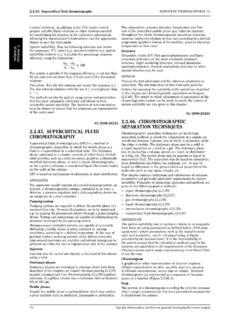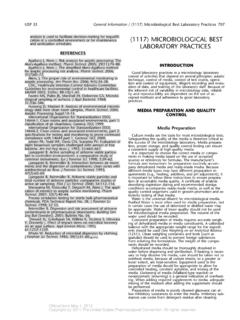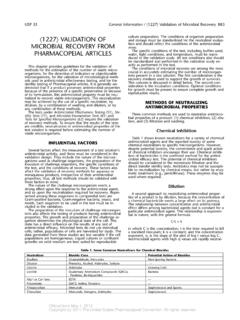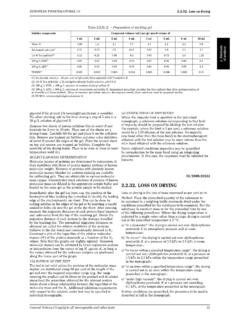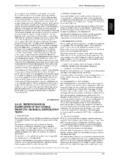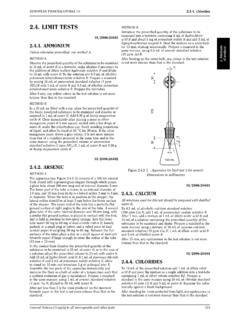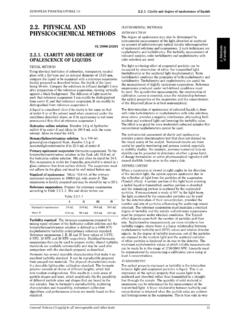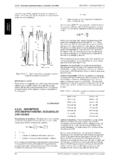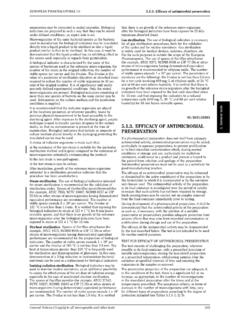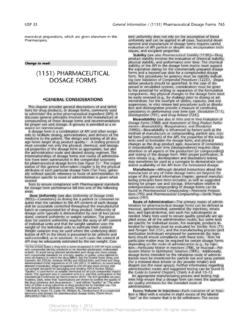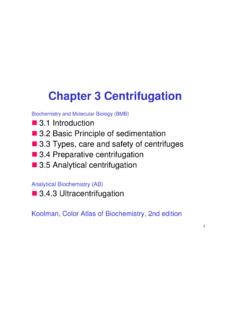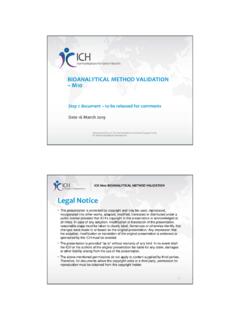Transcription of 2.4.24. IDENTIFICATION AND CONTROL OF RESIDUAL …
1 EUROPEAN PHARMACOPOEIA IDENTIFICATION and CONTROL of RESIDUAL solventsA=area of the peak due to the component to bedetermined,A =area of the peak due to betulin,m=massofthesampleofthesubstancet obeexaminedin grams,m =mass ofbetulin Radded in IDENTIFICATION AND CONTROLOF RESIDUAL SOLVENTSThe test procedures described in this general method may beused:i. for the IDENTIFICATION of the majority of Class 1 and Class 2residual solvents in an active substance, excipient or medicinalproduct when the RESIDUAL solvents are unknown;ii. as a limit test for Class 1 and Class 2 solvents when presentin an active substance, excipient or medicinal product;iii. for the quantification of Class 2 solvents when the limits aregreater than 1000 ppm ( per cent) or for the quantificationof Class 3 solvents when 1, Class 2 and Class 3 RESIDUAL solvents are listed ingeneral diluents are described for sample preparation and theconditions to be applied for head-space injection of the gaseoussample onto the chromatographic system.
2 Two chromatographicsystems are prescribed but System A is preferred whilst SystemB is employed normally for confirmation of identity. The choiceof sample preparation procedure depends on the solubility ofthe substance to be examined and in certain cases the residualsolvents to be following RESIDUAL solvents are not readily detected bythe head-space injection conditions described: formamide,2-ethoxyethanol, 2-methoxyethanol, ethylene glycol,N-methylpyrrolidone and sulfolane. Other appropriateprocedures should be employed for the CONTROL of these the test procedure is applied quantitatively to controlresidual solvents in a substance, then it must be by gas chromatography with static head-spaceinjection ( ).Sample preparation 1. This is intended for the CONTROL ofresidual solvents in water-soluble solution (1).
3 Dissolve g of the substance to beexamined inwater Rand dilute to mL with the preparation 2. This is intended for the CONTROL ofresidual solvents in water-insoluble solution (2). Dissolve g of the substance to beexamined inN,N-dimethylformamide R(DMF) and dilute mL with the same preparation 3. This is intended for the CONTROL ofN,N-dimethylacetamide and/orN,N-dimethylformamide, whenit is known or suspected that one or both of these solution (3). Dissolve g of the substance to beexamined in1,3-dimethyl-2-imidazolidinone R(DMI) and diluteto mL with the same appropriate, in which case the diluent to be used for thepreparation of the sample solution and the static head-spaceconditions to be employed must be demonstrated to be solution (a). 1 RESIDUAL solventsolution CRS,add9mLofdimethyl sulfoxide Rand diluteto mL withwater R.
4 Dilute mL of this solution to100 mL withwater R. Dilute mL of this solution to mLwithwater reference solutions correspond to the following limits: benzene:2ppm, carbon tetrachloride: 4 ppm, 1,2-dichloroethane:5ppm, 1,1-dichloroethene:8ppm, 1,1,1-trichloroethane: 10 solution (b). Dissolve appropriate quantities of theClass 2 RESIDUAL solvents indimethyl sulfoxide Rand dilute mL withwater R. Dilute to give a concentration of 1/20of the limits stated in Table 2 ( solvents).Solventsolution (c). in the substance to be examined indimethyl sulfoxide Rorwater R,ifappropriate, to give a concentration of 1/20 of the limit(s) stated inTable 1 or 2 ( solvents).Blank solution. Prepare as described for solvent solution (c) butwithout the addition of solvent(s) (used to verify the absence ofinterfering peaks).
5 Test solution. Introduce mL of the sample solution solution (a) (Class 1). Introduce mL of solventsolution (a) and mL of the appropriate diluent into aninjection solution (a1)(Class1). solution and mL of solvent solution (a) into aninjection solution (b) (Class 2). Introduce mL of solventsolution (b) and mL of the appropriate diluent into aninjection solution (c). Introduce mL of the sample solutionand mL of solvent solution (c) into an injection solution (d). mL of the appropriate diluent into an injection polytetrafluoroethylene and secure with an aluminiumcrimped cap. Shake to obtain a homogeneous following static head-space injection conditions may beused:Sample preparationprocedureOperating parameters123 Equilibration temperature ( C)8010580 Equilibration time (min)604545 Transfer-line temperature ( C)85110105 Carrier gas:Nitrogen for chromatography RorHelium forchromatography Rat an appropriate pressurePressurisation time (s)303030 Injection volume (mL)111 The chromatographic procedure may be carried out using:SYSTEM A a fused-silica capillary or wide-bore column 30 m long mm or mm in internal diameter coated withcross-linked 6 per cent polycyanopropylphenylsiloxane and94 per cent polydimethylsiloxane (film thickness: mor3 m), nitrogen for chromatography Rorhelium forchromatography Ras the carrier gas, split ratio 1.
6 5 with alinear velocity of about 35 cm/s,General Notices (1) apply to all monographs and other IDENTIFICATION and CONTROL of RESIDUAL solventsEUROPEAN PHARMACOPOEIA a flame-ionisation detector (a mass spectrometer may alsobe used or an electron-capture detector for the chlorinatedresidual solvents of Class 1),maintaining the temperature of the column at 40 C for 20 min,then raising the temperature at a rate of 10 C per min to240 C and maintaining it at 240 C for 20 min and maintainingthetemperatureoftheinjectionp ortat140 Candthatofthedetector at 250 C, or, where there is interference from thematrix, use:SYSTEM B a fused-silica capillary or wide-bore column 30 m long mm or mm in internal diameter coated withmacrogol 20 000 R(film thickness: m), nitrogen for chromatography Rorhelium forchromatography Ras the carrier gas, split ratio 1:5 with alinear velocity of about 35 cm/s.
7 A flame-ionisation detector (a mass spectrophotometermay also be used or an electron-capture detector for thechlorinated RESIDUAL solvents of Class 1),maintaining the temperature of the column at 50 C for 20 min,then raising the temperature at a rate of 6 C per min to 165 Cand maintaining it at 165 C for 20 min and maintaining thetemperatureoftheinjectionportat140 Candthatofthedetector at 250 1 mL of the gaseous phase of reference solution (a) ontothe column described in System A and record the chromatogramunder such conditions that thesignal-to-noise ratio for1,1,1-trichloroethane can be measured. The Figure 1 mL of the gaseous phase of reference solution (a1)ontothe column described in System A. The peaks due to the Class 1residual solvents are still 1 mL of the gaseous phase of reference solution (b)onto the column described in System A and record thechromatogram under such conditions that the resolutionbetween acetonitrile and methylene chloride can be system is suitable if the chromatogram obtained resemblesthe chromatogram shown in Figure and the resolutionbetween acetonitrile and methylene chloride is at least 1 mL of the gaseous phase of the test solution onto thecolumn described in System A.
8 If in the chromatogram obtained,there is no peak which corresponds to one of the residualsolvent peaks in the chromatograms obtained with referencesolution (a) or (b), then the substance to be examined the test solution corresponds to any of theresidual solvent peaks obtained with reference solution (a) or(b) then System B is to be 1 mL of the gaseous phase of reference solution (a) ontothe column described in System B and record the chromatogramunder such conditions that the signal-to-noise ratio for typical chromatogram is shown in Figure 1 mL of the gaseous phase of reference solution (a1)ontothe column described in System B. The peaks due to the Class Iresidual solvents are still 1 mL of the gaseous phase of reference solution (b)onto the column described in System B and record thechromatogram under such conditions that the resolutionbetween acetonitrile and trichloroethene can be system is suitable if the chromatogram obtained resemblesthe chromatogram shown in Figure and the resolutionbetween acetonitrile and trichloroethene is at least 1 mL of the gaseous phase of the test solution ontothe column described in System B.
9 If in the chromatogramobtained, there is no peak which corresponds to any of theresidual solvent peaks in the chromatogram obtained withthe reference solution (a) or (b), then the substance to beexamined meets the requirements of the test. If any peak inthe chromatogram obtained with the test solution correspondsto any of the RESIDUAL solvent peaks obtained with referencesolution (a) or (b) and confirms the correspondence obtainedwhen using System A, then proceed as 1 mL of the gaseous phase of reference solution (c) ontothe column described for System A or System B. If necessary,adjust the sensitivity of the system so that the height of thepeak corresponding to the identified RESIDUAL solvent(s) is atleast 50 per cent of the full scale of the 1 mL of the gaseous phase of reference solution (d) ontothe column.
10 No interfering peaks should be 1 mL of the gaseous phase of the test solution and 1 mLof the gaseous phase of reference solution (c) on to the these injections twice (s)inthechromatograms obtained with the test solution is not greaterthan half the mean area of the peak of the correspondingresidual solvent(s) in the chromatograms obtained withreference solution (c). The test is not valid unless the relativestandarddeviationofthedifference sinareasbetweentheanalyte peaks obtained from three replicate paired injections ofreference solution (c) and the test solution, is at most 15 flow diagram of the procedure is shown in Figure a RESIDUAL solvent (Class 2 or Class 3) is present at a levelof per cent or greater then the content may be quantitativelydetermined by the method of standard the information section on general monographs (cover pages)
